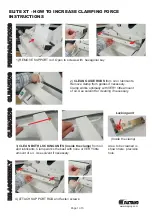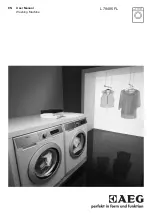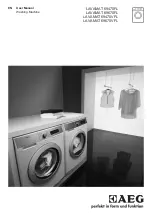
– 5 –
❶
❷
❺
❹
❸
❽
❻
When opening valve
❺
, be aware that the air-supplied mechanism is partly activated.
If the air supply source pulse is too large, even at the above setting value the emergency
signal might go off.
3-3. Installing the air hose and air gun and adjusting the pressure
(Open) (Shut)
A
B
C
D
❼
❾
(1) Connecting the air
hose
1) Connect fitting
❶
to plug
❷
. At this time, wrap
sealing tape or the like
round the screw.
2) Insert air hose
❸
into fit-
ting
❶
and fasten them
with hose band
❹
.
(Use the correct air hose
to match the fitting.)
(2) Connecting the air gun
Insert the coil tube of air gun
❼
into quick-coupling joint
❽
and put the air gun on
L-shaped fitting
❾
.
(3) Opening/closing the valve
To open/close valve
❺
, turn the valve until it will go no further (by 90 degrees of an
angle).
(4) Adjusting the supply air pressure
1) The operating air pressure should be set to 0.5 MPa.
2) Deliberately open valve
❺
.
3) Lift regulator knob
❻
in direction
A
. Turning it in this state will change the sup-
ply air pressure. Turn knob in direction
C
(+) or in direction
D
(–) so that black
point of pressure gauge
indicates 0.5 MPa. After the adjustment, lower knob
❻
in direction
B
to securely lock it.
(5) Pressure drop signal adjustment
1) Set the pressure at which an emergency signal will go off if the pressure drops below it.
2) The normal setting value is 0.4 MPa.
3) Insert a small screwdriver into cap
of pressure gauge
, and adjust screw
which is inside. Turn the
screw with the screwdriver until the green pointer points to 0.4 MPa.
(6) Discharging the drainage
1) Remove the drain from regulator before use to discharge water (by loosening knob
).
2) Water adversely affects the air control components. It is therefore necessary to carefully remove the water.
3) If the air pressure in regulator drops, the pressure gauge switch comes on to cause an error.










































